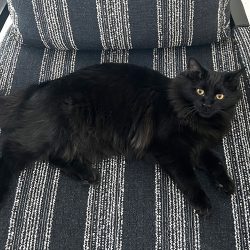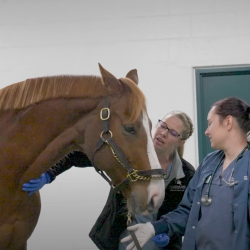By Caroline Burglass, DVM; Aimee Colbath, DVM, MS, PhD; Melissa Esser, DVM, MS, DACVIM; Julie White, DVM; Lauren Bookbinder, DVM; Samantha Eldred, DVM Class of 2020; Ally Tucker, DVM Class of 2020; Ani Sefildzhian, Ross University School of Veterinary Medicine Class of 2020; Sarah Tritt, DVM Class of 2020; Chris Chess, DVM Class of 2020; Peter Fowler, DVM Class of 2020
History and Presentation

Leo is a two-year-old Holstein/Jersey steer that presented to Michigan State University’s Large Animal Emergency Service for signs of colic that had been present for three days. His owners initially noticed that he was separated from the herd; this progressed to flank watching, kyphosis, and other signs of colic. Prior to coming to MSU, Leo had received flunixin meglumine (Banamine), dexamethasone, oxytetracycline, and ampicillin for three days for the treatment of hardware disease. He also was administered a magnet orally. Failure to respond to medical management on the farm prompted Leo’s referral.
Leo lives on a sanctuary farm with 17 other bovines, as well as many other animals. On pasture, Leo is free to roam 60-acres of land. In addition to pasture grazing, Leo and his pasture-mates are given grain as part of their daily diet. Leo was born at the farm and has remained there his entire life.
On presentation, Leo was bright, alert, and responsive. He had an increased heart rate and decreased gastrointestinal sounds. On rectal palpation, his gastrointestinal tract felt empty and a large bladder could be appreciated. He had a negative “grunt” test. When viewed from behind, his abdomen was symmetrical and free of abnormal distention.
Diagnosis

Leo was initially diagnosed with obstructive urolithiasis, uroabdomen, and rumen dysbiosis/vagal indigestion. He was hospitalized at MSU and treated for uroabdomen secondary to obstructive urolithiasis.
Following admission, an abdominal drain was placed percutaneously into Leo’s abdomen to assist urine drainage. A temporary perineal urethrotomy (PU) was performed for endoscopic evaluation of the urinary tract. Leo’s bladder was found to be necrotic and contained mats of fibrin in numerous locations. However, a discrete tear or complete opening into the abdomen was not visualized endoscopically. Uroliths were identified in the urethra at the level of the sigmoid flexure. Leo was initially maintained with a temporary PU prior to surgical removal of the distal urethral uroliths.
Treatment and Outcome
Once Leo was stabilized, an exploratory laparotomy confirmed a bladder rupture with significant adhesions. During the surgery, the uroliths were removed from the urethra and the bladder was repaired.

Unfortunately, following surgery Leo was inappetent and was treated with repeat rumen transfaunations for rumen dysbiosis. Leo’s appetite initially improved, however Leo became colicky again. As there was no evidence of a uroabdomen, an exploratory laparotomy was recommended and pursued.
Leo’s second exploratory laparotomy revealed extensive abdominal adhesions. Adhesions were broken down as much as possible, and the abdomen copiously lavaged. Following Leo’s second surgery, he was again inappetent and was treated with repeat rumen transfaunations for suspected rumen dysbiosis. He responded well to treatment, and his appetite again improved. At time of initial discharge, Leo still had a temporary and patent perineal urethotomy site. Leo was discharged with detailed instructions for monitoring and care of the PU site.
Three months following his initial discharge from MSU, Leo represented to MSU for stricture of the temporary PU site and colic signs. A permanent urethrostomy was performed under standing sedation and local anesthesia. Cytologic evaluation of a urine sample revealed a highly resistant urinary bladder infection. Antibiotic treatment was selected from culture and susceptibility testing, and the bladder was lavaged with hypertonic saline. Following treatment, Leo was discharged from the Hospital and has done well at home.

Comments
The treatment of urolithiasis is multifaceted. Of immediate concern is the obstruction to the urinary tract which necessitates surgical intervention. But rerouting the flow of urine can result in additional management challenges including urine scald and urinary tract infection.
Leo’s initial PU site was temporary. This is often done to allow the rest of the urinary tract to rest and potentially repair. When repair and restoration of normal urine flow does not occur, a permanent PU can then be performed. The management of a permanent PU includes frequent cleaning for prevention of urine scald and monitoring for stricture of the PU site. Leo will be carefully managed at home and return to his herd and continue to enjoy life at the sanctuary.



